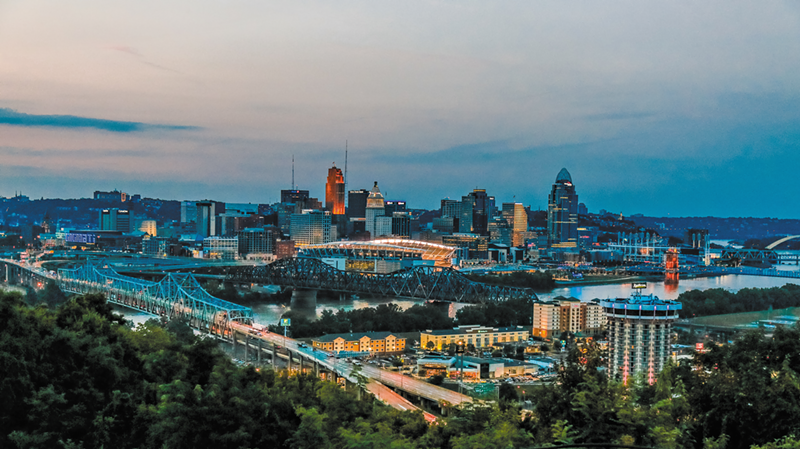In 1963 legendary Soul singer Sam Cooke wrote “A Change is Gonna Come.” That same year, the average global carbon dioxide levels in the atmosphere were around 319 parts per million (ppm), according to data from NASA. And though that’s not the kind of change Cooke was singing about, in the 56 years since his hit single, change has indeed come. This May, data from Hawaii’s Mauna Loa Observatory showed that CO2 levels had surpassed 415 ppm for the first time in human history.
In less than 60 years, CO2 levels have increased nearly three times as much as they did in the previous 113 years. While our planet is a dynamic and complex system, research has shown that increases in atmospheric CO2 boost global temperatures. Worldwide, scientists and citizens alike are bracing for the impacts of a warmer world, which include rising sea levels, ocean acidification, drought, famine and megastorms.
But how will Cincinnati, a city not situated on the coast and with ample fresh water for drinking and farming, fare as our global climate systems shift? The Mercantile Library, in partnership with Cincinnati’s Center for Public Engagement with Science, will host a three-part series to address that very question this fall, starting with “Understanding Climate Change” on Aug. 29.
One of the experts involved is Dr. Brenda Hunda, curator of invertebrate paleontology at the Cincinnati Museum Center. She says that several climate models have predicted drastic changes to the Ohio River Valley.
“For starters, this region will be hotter, with a possible 12.3 percent increase in average annual temperature, which means more high heat index days throughout the year,” Hunda says.
Southwest Ohio will likely also experience more severe weather events similar to the tornadoes that hit Dayton earlier this spring; more rainfall is also expected.
“Increased precipitation means more water on and in our clay-rich hillsides,” Hunda says. “Wetter springs typically result in more slope failure, and these events can be expected to be more frequent with increased rainfall in the region.”
Commuters who take Columbia Parkway have likely experienced that first hand — parts of the busy road have closed multiple times this year due to heavy rains and resulting mudslides. But outside of the urban core, flooding can be particularly damaging to agriculture. Numbers released by the U.S. Department of Agriculture found that this has been the worst planting season on record for Ohio farmers — one of every seven acres of Ohio cropland went unplanted this year.
As Nicole Gunderman, director of education at Gorman Heritage Farm, explains, farmers have always faced weather challenges, but now with more severity and frequency.
“I think one of the biggest messages we need to get across about climate change is how it brings erratic, unpredictable and unrelenting changes in weather patterns,” says Gunderman, who will participate in the Mercantile’s Oct. 3 event, “Climate Change and Cincinnati Life.”
Certainly, everyone will feel the heat of a warmer world. But that’s not to say everyone will feel climate change’s impacts equally — 45.3 percent of children within Cincinnati’s city limits live below the poverty line, according to data from the National Center for Children in Poverty. That’s the fourth highest rate in the U.S. among major cities.
Dr. Carlie Trott, a community psychologist and assistant professor at the University of Cincinnati, will speak alongside Hunda on how climate change will “exacerbate existing inequalities by disproportionately affecting the most vulnerable and marginalized groups — the youngest and oldest Cincinnatians, people of color and the poor.”
A third of Cincinnati families also have food insecurity. Dr. Nancy Tuana, a professor of philosophy and women’s, gender and sexuality studies at Penn State University, will explore these issues even further on Sept. 12 during “Climate Change and Social Justice.” She says that higher food prices caused by drought conditions and famine would likely cause more families to struggle to feed their kids. Today’s kids will also be responsible for mitigating and baring climate change’s worst effects — by the time today's children reach their 30s and 40s, average global temperatures will likely increase by at least 1.5 degrees Celsius, the level associated with major climate disruption.
So what can cities do to protect their citizens from the impacts of climate change? Without leadership at the federal and, at least in Ohio, the state level, cities will be key in implementing policies and programs to fight climate change’s effects. Cincinnati is part of the Climate Mayors effort, a network of U.S. mayors working together to transition their cities to run more sustainably.
In 2018, the city adopted the Green Cincinnati Plan as a citywide effort to link sustainability and equity. This includes support for urban agriculture programs, efforts to reduce food waste, and support of “green jobs” that produce goods and services with positive environmental and social impacts.
“New jobs will arise from energy efficiency improvements, as well as from increased commitment to the wind and solar industry, as well as to the electric vehicle industry,” Trott says. “Ensuring that those in the most need of jobs have the training they need to participate in this effort and take advantage of these new jobs can have an important impact on the environment and poverty.”
However, Dr. Brooke Crowley, associate professor of geology and anthropology at UC, says that Cincinnati is no island.
“Most of the food we eat is not produced locally, and we rely on goods imported from distant places,” Crowely says. ”Prices will increase and availability of some commodities will likely decline.”
Since Cincinnati will be less drastically impacted by climate change than other places around the world, our region could see an influx of immigration. While this could boost the region’s economy, without proper planning it could also result in increased traffic congestion, stress on infrastructure and a spike in the housing market.
While there is uncertainty about how climate change will affect us throughout the 21st century, two things are clear: If we keep increasing the amount of CO2 in our atmosphere, things will get worse; and while the lives of every person on this planet will change with a warming world, it will be our most vulnerable — specifically the poor, the elderly and children — who will feel the greatest heat.
The Mercantile Library will host a three-part Science & Nature Lecture about climate change, starting on Aug. 29 with “Understanding Climate Change,” followed by “Climate Change and Social Justice” on Sept. 12 and “Climate Change and Cincinnati Life” on Oct. 3. More info: mercantilelibrary.com.






